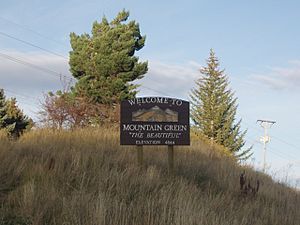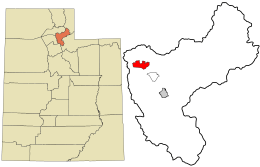Mountain Green, Utah facts for kids
Quick facts for kids
Mountain Green
|
|
|---|---|

Welcome sign
|
|

Location in Morgan County and the state of Utah
|
|
| Country | United States |
| State | Utah |
| County | Morgan |
| Area | |
| • Total | 5.5 sq mi (14 km2) |
| • Land | 5.4 sq mi (14 km2) |
| • Water | 0.1 sq mi (0.3 km2) |
| Elevation | 4,915 ft (1,498 m) |
| Population
(2020)
|
|
| • Total | 4,231 |
| • Density | 769/sq mi (297.0/km2) |
| Time zone | UTC-7 (Mountain (MST)) |
| • Summer (DST) | UTC-6 (MDT) |
| ZIP code |
84050
|
| Area code(s) | 385, 801 |
| GNIS feature ID | 2584772 |
Mountain Green is a small community in Morgan County, Utah, in the United States. It is known as a census-designated place, which means it's a community that the government counts for population, but it's not officially a city or town. In 2020, about 4,231 people lived there.
Mountain Green is located about 16 miles from Ogden, along the Weber River. It is also home to the main office of the Browning Arms Company, a famous company that makes firearms.
Contents
Exploring Mountain Green's Location
Mountain Green is in a valley called Morgan Valley. It sits at the eastern end of the lower Weber Canyon. You can find it just north of I-84, where it meets Utah State Route 167, also known as Trappers Loop. This community is in the northwest part of Morgan County. It also has the lowest elevation point in the entire county.
A Look Back: Mountain Green's History
The Historic Deserters Point Meeting
The area where Mountain Green is today was once the site of an important meeting in May 1825. Three groups of mountain men, who were fur trappers, gathered here.
- Peter Skene Ogden led 58 trappers from the British Hudson's Bay Company. They camped here on May 22, 1825.
- The next day, 25 American trappers from the Rocky Mountain Fur Company arrived. They were part of John Henry Weber's group, led by Johnson Gardner.
- Étienne Provost was also in the area with his own group of 15 trappers.
On May 24, 1825, a leader named John Gray, who was part-Iroquois, decided to leave Ogden's group. He and other trappers were unhappy with their pay and working conditions. They had spent time with Johnson Gardner's American group. The Americans came with them to support their plan to leave. In the end, 23 Hudson's Bay Company trappers left, taking about 700 animal furs with them. Ogden and his remaining men left the next day.
This meeting caused a disagreement over who owned the land. Gardner and his men said the British trappers were on United States land. Ogden argued that the area was controlled by both the U.S. and the United Kingdom. Provost, who stayed out of the argument, actually had the best claim. The Adams–Onís Treaty of 1819 had given Spain rights to the land south of the 42nd parallel. Then, in 1822, control went to Mexico, which had given Provost a license to trap there.
The trappers who left the Hudson's Bay Company joined the Americans. They traveled about 120 miles east to Henrys Fork (Green River). There, on July 1, 1825, they held the first of sixteen Rocky Mountain Rendezvous. These were big meetings organized by fur trader William H. Ashley. For many years, American trappers had traveled up to 2,000 miles to sell their furs in places like St. Louis. For Spanish trappers, Taos was a common place to trade.
This spot became known as Deserters Point. Today, there is a rest stop there with a historical marker. The road that connects Mountain Green to the Ogden Valley is called Trappers Loop, named after these early fur traders.
Early Settlement of Mountain Green
When Mormon pioneers arrived in Morgan County in the 1850s, they found a man named Ben Simon already living in the Mountain Green area. The Mexican government had given Simon permission to use this land for grazing cattle before 1848. He and his brother James had been trading with the Shoshone people in the area for about 20 years.
Early settlers like George W. Higley and Gordon Beckstead moved to Mountain Green in the 1850s. They had permission from the Simons and the Native Americans. The settlement was named Mountain Green because of its many green grasses. In 1877, about 150 people lived there. However, some families left because they feared conflict with the Native Americans. By the 1880 census, only 75 residents remained.
Mountain Green in Modern Times
Around 1960, the Browning Arms Company, which was based in Ogden, needed a place in the countryside to test their firearms. They bought a farm in Mountain Green in 1961. By 1968, Browning had moved its main offices, research and development, sales, and data processing to this location in Morgan County.
A volunteer fire department called the Mountain Green Fire District started in July 1971. It was created because people felt they needed faster help than the county fire station in Morgan, which was about 10 miles away. A separate fire station was built in 1973. In 1997, the Mountain Green Fire District received a good rating for its fire fighting services.
Mountain Green has not officially become a city or town, and much of it is still undeveloped. However, it is growing quickly. In 2007, a group of architects helped plan ideas for a new town center in Mountain Green.
Population and Community Life
Since Mountain Green is not an official city, it doesn't have exact borders. This means that population numbers can change. In 2003, an unofficial count estimated that about 4,000 people lived there. This was about half of the total population of Morgan County at the time.
According to the census of 2010, there were 2,309 people living in the community. Most of the people were White (97.8%). A small number were Asian (0.9%), American Indian and Alaska Native (0.1%), or from other backgrounds. About 2.1% of the population was Hispanic or Latino.
Learning in Mountain Green
Mountain Green has its own schools for younger students. These are Mountain Green Elementary School and Mountain Green Middle School. Older students attend Morgan High School, which is located in the nearby town of Morgan.
See also
 In Spanish: Mountain Green (Utah) para niños
In Spanish: Mountain Green (Utah) para niños


